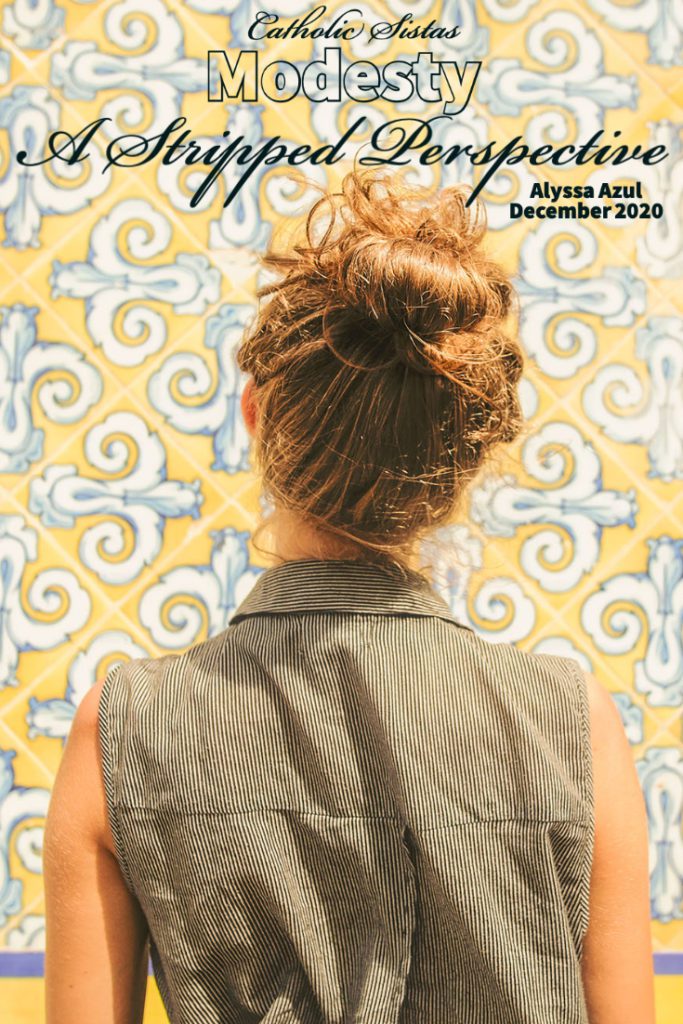
Growing up modesty was taught to me in relation to what I wore. It was a sin to show too much skin, wear clothing that accentuated curves, or wear too much makeup. I’ve seen girls reprimanded publicly for their clothing, and I also heard that it is a girl’s fault if a guy lusts after her. It’s only a matter of time before she associates modesty with shame, thinking society resents something about the female body. There’s a real problem with this approach.
The truth is, modesty is not simply a way of dress, but a virtue. In my experience raised in the church and serving in ministry for almost 10 years, an open discussion on this topic never happened. Unaddressed, it remained a thorn in my side. My own lack of understanding regarding modesty caused me to be resentful towards men and insecure about my body.
I’m only scratching the surface, but I’ve taken what I’ve learned from Pope John Paul II’s Theology of the Body coupled with my lived experience to deepen my understanding of the wounds which a lack of modesty may flow from.
Why might modesty be a struggle for her?
She feels ashamed.
She feels embarrassed about the parts of her body that she is told to “cover up”. If showing too much skin is a sin, then her breasts, hips, and all parts of her body that make her feminine are wrong. She feels guilty for wanting to look nice.
Response:
Understand that the aspirations for beauty and adoration is not a sin, or something to be ashamed of. Pope John Paul II said “by modesty the human being manifests almost ‘instinctively’ the need for this ‘I’ to be affirmed and accepted according to its true value.”(General Audience, 1979). The need to be affirmed comes from our deepest desires as women to be seen. When Eve was created, she was first seen by God, then by Adam. Adam, on the other hand, was made to seek. Our desire to be seen is manifested when we choose to present ourselves in ways that attract love. The parts of our bodies that we might feel shame about have a divine function – to create and nurture life. Modesty aims to protect that, so that it is only seen according to its true value.
She feels repressed.
Believing that it is liberating, she tries to dress in ways that the media or others show as empowering. She feels as though dressing the way that she wants is how she can “take control back” of her body. She may think modesty is not for her.
Response:
Due to our fallen natures as men and women, our good desires have been twisted, which results in the toxicity we see in the world today (ie. the sexual revolution, hook-up culture, etc.) Man’s nature to seek has been distorted to see people as a sum of parts, to objectify for his use. Woman’s desire to be seen is distorted to accept attention from anyone and anywhere, at the expense of her dignity. The world has successfully convinced people that bodies are expendable, which results in the connection between the body and soul being metaphorically “severed”. We all seek to love and be loved, but the truth of authentic love of the person is lost in the noise of a culture that screams self-gratification, loneliness, and pride. Dr. Edward Sri says that “modesty is about inspiring a reaction to the value of the person not just to the sexual values.” Contrary to what many people think, modesty is not repressive, but rather freeing once you understand what you are being freed from.
She is confused.
She doesn’t understand why it’s her responsibility to dress a certain way to keep men from objectifying her.
Response:
As mentioned before, men’s desires are distorted due to their fallen natures, so their journey towards purity looks different than ours. . . a topic of its own for another day! While it’s true that women have a role to play in averting a man’s gaze by dressing in modest attire, I am a firm believer that a woman needs to find the reason to do it for herself. Young girls need to know that they have the power to protect, preserve, and uphold their dignity as a person by making their own choices. Self-esteem is so important. When you have love for yourself, you begin to understand what about you is worth honoring, and what is equally worth honoring in others. A woman who understands that her body is a reflection of her God-given soul and fights to protect that, is frankly, more empowering than who you might find on the cover of Sports Illustrated. Modesty is driven by the commitment to see others and be seen as a whole person, rather than as a sum of parts. With that idea in mind, the conversation on clothing and physical presentation might make more sense.
So what now?
Believe me, no one is perfect. As I write this, I am mulling over whether or not the ripped jeans I’m wearing could even be considered pants. Keeping up with trends and beauty standards today is hard enough, so compassion goes a long way. Clothing decisions are not always black and white because bodies come in all shapes and sizes. This is where building a strong sisterhood is important. I hope we can move towards a place where girls growing up today understand modesty by being taught the beauty and sanctity of their bodies rather than by a slap on the wrist. We’re in this together and we have a responsibility to not only hold our brothers accountable, but our sisters as well. Affirm and uplift each other. Share your wounds. Educate and empower.
Related Resources:
Theology of the Body Explained-Revised Edition by Christopher West
Come, Holy Spirit, Give Us Modesty
